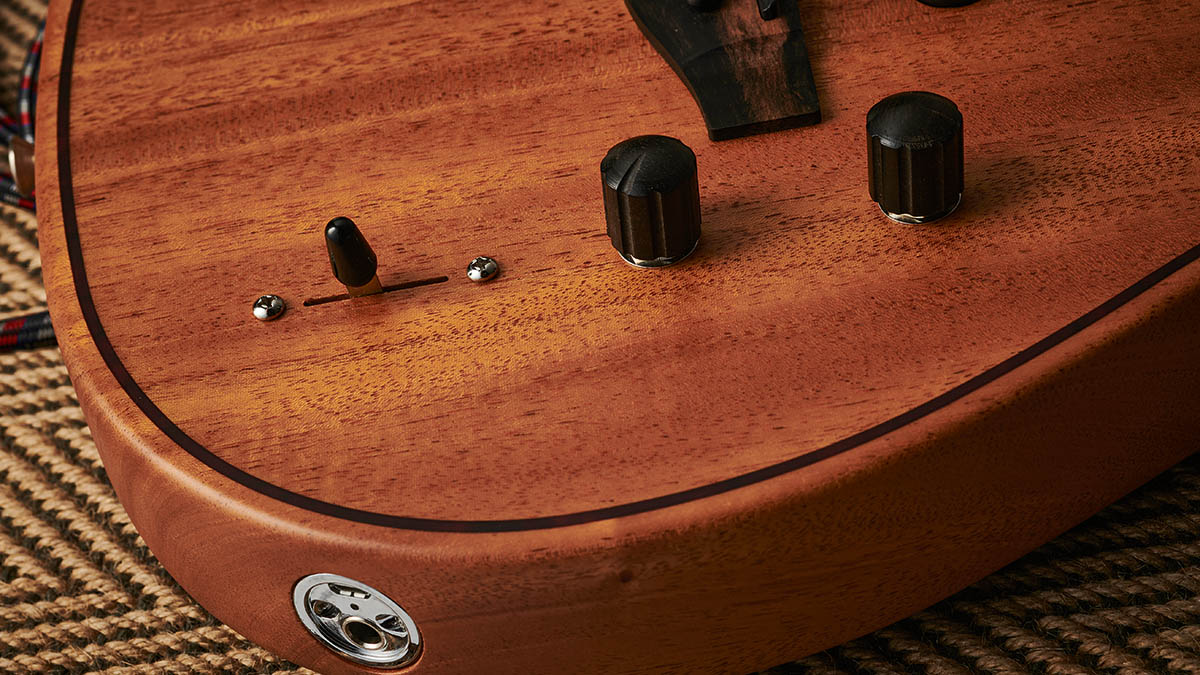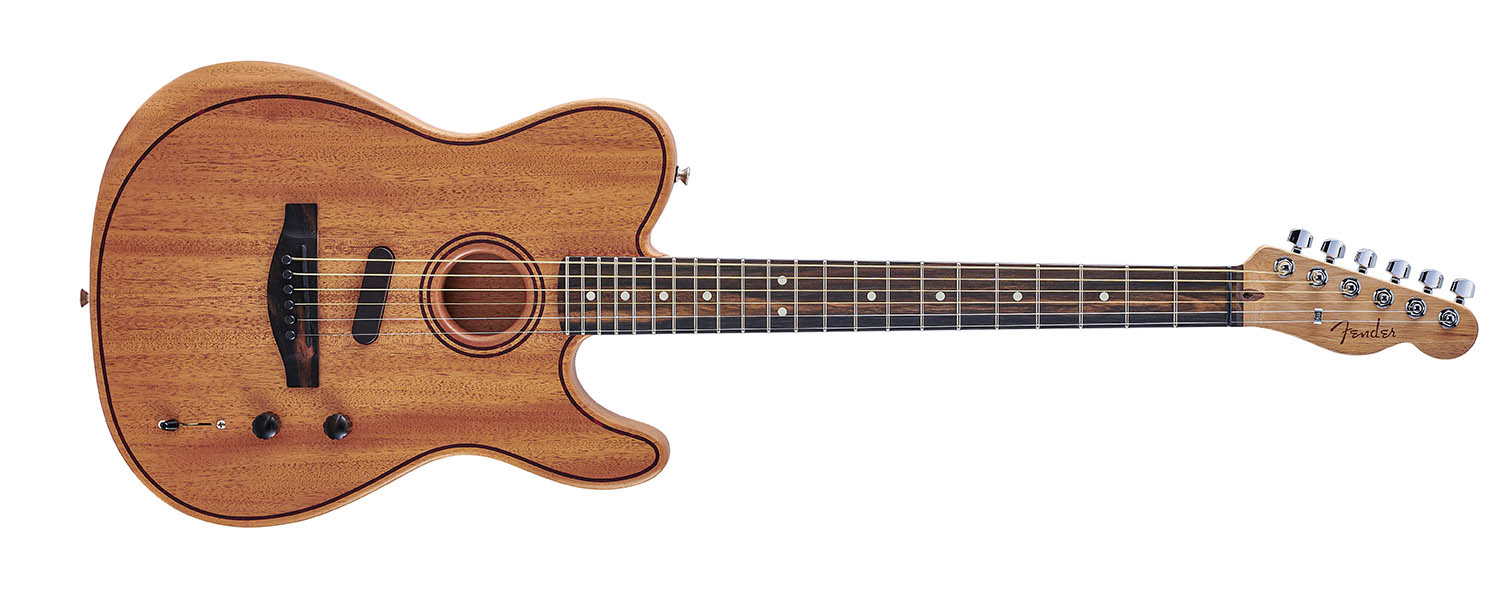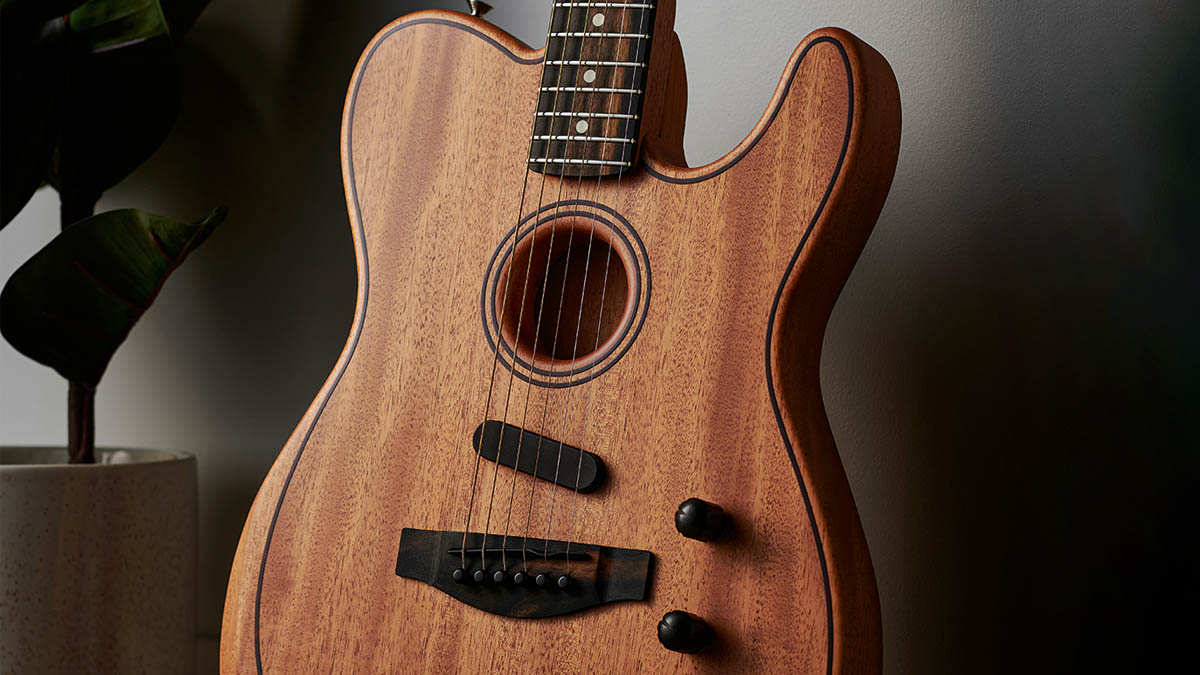MusicRadar Verdict
An all-mahogany version of the American Acoustasonic Telecaster is not going to persuade anyone who finds the whole project a little radical for their tastes but it adds another superb hybrid option for the adventurous player – those who find this supremely well-balanced and comfortable acoustic electric to be the sound of the future.
Pros
- +
Offers a huge array of acoustic-electric tones.
- +
Subtly different to the Sitka spruce models
- +
It looks good.
- +
Lightweight.
Cons
- -
More finish options with the Sitka spruce models.
MusicRadar's got your back
Fender American Acoustasonic Telecaster All-Mahogany: What is it?
Ordinarily, whenever Fender releases a new Acoustasonic model, our attention is first commanded by this hybrid acoustic electric guitar’s clever design – the Acoustic Engine co-developed with Fishman, the next-gen patent-applied-for soundhole, aka the Stringed Instrument Resonance System (SIRS), and the fact that really does blur the line between acoustic and electric guitar.
The success of the Acoustasonic platform, however, has changed that. Of course, that success is still qualified by its detractors, but by now they’re irrelevant because the design as a concept – as an instrument – has been proven to be seaworthy. It has its audience. But now, whenever there is a new model the talking points are more quotidian concerns such as price and finishes. Or, as in the case of the headline item with this new Acoustasonic, the tonewoods used.
The original runs of the American Acoustasonic Telecasters have of course used mahogany for the back and sides, the neck too, but here Fender has done away with the Sitka spruce altogether. Here we’ve got a feast of mahogany, top, back, sides, and neck, with ebony used for the fingerboard and bridge.
Tonewood orthodoxy tells us that this might well make for a deeper, warmer sounding instrument, a little mellower in the high-end, more substance in the lower mids. It’s a tantalising prospect, and one that Fender has offered for this Telecaster and the Jazzmaster. Spec-wise, this is no quantum leap from its Acoustasonic siblings – though the more affordable Acoustasonic Player models have scaled-down electronics.
Once more there is the three-pickup configuration that deploys a Fishman transducer under the saddle, a sensor on the bridge plate, and a magnetic N4 noiseless pickup mounted by the bridge. Where things get really clever is in how you can mix and match sounds.
Fender’s Acoustasonic platform is not just a hybrid of acoustic and electric technologies, but of modelling; this might be a mahogany model but thanks to the Acoustic Engine you have 10 different body styles and tonewood combos available, and you can blend them to find hybrid in-between sounds.
As with the spruce-topped model, the modified Telecaster body has a forearm contour for comfort, a Modern Deep C neck profile. The fingerboard has clay dot markers, 22 narrow-tall frets, and a 12” radius. In many respects, it’s the same guitar, albeit swapping out the spruce top for mahogany, with colour options including Natural and Bourbon Burst.
Want all the hottest music and gear news, reviews, deals, features and more, direct to your inbox? Sign up here.

Fender American Acoustasonic Telecaster All-Mahogany: Performance and verdict
As with the other American Acoustasonics to come out of Fender’s Corona, California facility, the craft here is not to be sniffed at. Shipping with bronzed acoustic guitar strings, as per house style, reminds us that it’s an acoustic guitar, albeit one that’s assumed the hollowed-out form of a Telecaster. When played acoustically, it is more than loud enough for practice, even if in performance situations you are going to want an acoustic guitar amp to hand.
The neck, a Modern Deep C profile that puts it in line with something such as the American Professional II series, is nonetheless electric, and with guitar playing a tactile business, this electric neck with acoustic strings is where many players will first reconcile themselves with what the Acoustasonic’s hybrid design involves.

• Fender Player Acoustasonic Telecaster
The onboard voice options might have been scaled down but the Acoustasonic Telecaster sticks the landing as a Player Series model, in what could be one of the guitars to make the hybrid build truly go mainstream.
• Fender American Acoustasonic Telecaster
The original Acoustasonic trailblazer with spruce top insert, and now Fender offers it in a variety of finishes.
• Fender American Acoustasonic Jazzmaster
If you lean on a looper for live performance, it could be a real gamechanger. If you’re in a function band and want to move between worlds with ease, it’s a solution. Above all, it’s a really enjoyable and inspiring guitar to play.
If it ever felt radical and far out to put a set of 7s on your Telecaster for kicks, playing acoustic guitar on an electric guitar is really something. Electric players might find it stiffer. Acoustic players might find it slinky. What is a successful hybrid design if there’s not some sort of compromise, right?
Like the AmPro II models, the neck heel is sculpted a little, which is an invitation to players of all stripes to mosey on up the fingerboard and explore. But if we’re talking exploration, it’s that Acoustic Engine that is doing the heavy lifting and offering players the most room to investigate.
The sounds on offer are arranged in pairs, each accessed via a five-way blade selector switch. Once you’ve parked the blade selector, use the Mod knob to choose from one voice or another, or to blend them both together. Fender’s tagline reads, “Acoustic. Electric. Everything in between.”
That’s what you get here, as the pickups register the strings and the body’s vibrations, then process the signal digitally, so that you could put Sitka spruce back on the table simply by selecting positions 2 or 4, the former allowing you to blend a spruce/mahogany dreadnought with the N4 electric pickup, the latter brings a parlour-size Engelmann spruce-topped maple acoustic, meaning you can combine the big and bold lower-mid strumming power of a dread.
If nothing else, the Acoustasonic experiment has proven the viability of mixing in a magnetic pickup with the naturalistic acoustic boom of the dreadnought.
Sound differences from the spruce-topped models are not as dramatic as they might be if this were an all-acoustic design. It sounds sweet, and maybe you get a little more of a Delta blues vibe when strumming it unplugged. And dressed head to toe in mahogany, with the ebony reprised for the mod and volume dials, it looks the part.

Those who are already onboard with the Acoustasonic will definitely want to audition this. Of course, the same limitations remain. There is no dedicated tone knob, which would be nice if you are spending time on the N4 magnetic pickup. That said, as with the Sikta spruce model, the compressed Telecaster vibe on position 1 is still very cool, particularly if you dial in a little bit of grit via the Mod control.
There is something for pretty much everyone here, so long as you’re not an avowed nylon-string player. Position 3 with its Sikta spruce/Brazilian rosewood tone model offers plenty of potential for the modern percussive player, while the acoustic sounds at position 5 might be described as “traditional” but are super versatile, especially when blended.
MusicRadar verdict: An all-mahogany version of the American Acoustasonic Telecaster is not going to persuade anyone who finds the whole project a little radical for their tastes but it adds another superb hybrid option for the adventurous player – those who find this supremely well-balanced and comfortable acoustic electric to be the sound of the future.
Fender American Acoustasonic Telecaster All-Mahogany: The web says
"By design, the acoustic voice is surprisingly full – certainly loud enough for solo practice and sofa noodling. And although the sound engine is the same as the standard spruce-topped version, the acoustic sounds take on a slightly pushier voice, seemingly slightly compressed (in a good way) and more rootsy with it.
"While it all sounds rather good through an acoustic amp or PA, plugging into your electric rig and pedalboard really expands the possibilities for the more creative players out there, and that Sound 2 acoustic/electric mix really blurs the lines."
Guitarist
Fender American Acoustasonic Telecaster All-Mahogany: Hands-on demos
Fender
Fender American Acoustasonic Telecaster All-Mahogany: Specifications

- ORIGIN: USA
- TYPE: Single-cutaway, solidbody-sized electro-acoustic
- BODY: Mahogany (hollow) with inset mahogany top
- NECK: Mahogany, modern ‘deep C’ profile, bolt-on
- SCALE LENGTH: 648mm (25.5”)
- TUNERS: Fender standard cast/sealed staggered tuners
- NUT/WIDTH: Graph Tech Black Tusq/43.3mm
- FINGERBOARD: Ebony, ‘clay’ dot markers, 305mm (12”) radius
- FRETS: 22, narrow/tall
- BRIDGE/SPACING: Ebony w/ compensated Black Tusq saddle/52mm
- ELECTRICS: 3-pickup configuration: Fishman under-saddle transducer, bridge plate body sensor, Fender Noiseless N4 magnetic; master volume, mod knob, 5-way voice selector switch; single mono output with USB battery charge
- WEIGHT (kg/lb): 2.23/4.9
- LEFT-HANDERS: Yes, with spruce top (£1,749)
- FINISHES: Natural (as reviewed), Bourbon Burst – polyester satin matt to body; satin urethane to neck and headstock
- CONTACT: Fender
MusicRadar is the number one website for music-makers of all kinds, be they guitarists, drummers, keyboard players, DJs or producers...
- GEAR: We help musicians find the best gear with top-ranking gear round-ups and high-quality, authoritative reviews by a wide team of highly experienced experts.
- TIPS: We also provide tuition, from bite-sized tips to advanced work-outs and guidance from recognised musicians and stars.
- STARS: We talk to musicians and stars about their creative processes, and the nuts and bolts of their gear and technique. We give fans an insight into the craft of music-making that no other music website can.

